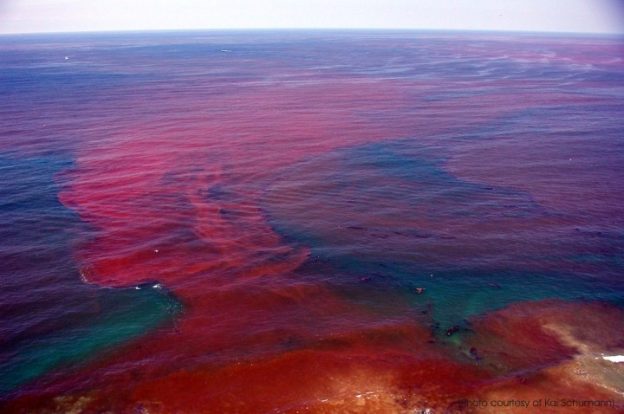Algal blooms occur when environmental conditions allow explosive growth of phytoplankton — a bloom — that can change the color of ocean water. In order for a bloom to occur, there has to be just the right “recipe” of environmental factors:
- Bright sunlight;
- High nutrient levels;
- Calm waters (low wind and circulation);
- Limited number of grazers or predators;
- Other environmental factors can be temperature and salinity, which influence HABs differently but may help in determining the sources of blooms.
Each type of algae has its own preferences of environmental factors; that is, the recipe changes depending on the species.
Most algal blooms are natural and essential components of any marine ecosystem — and most are nontoxic. However, harmful algal blooms can harm or kill marine animals, contaminate shellfish and threaten human life.
Visible algal blooms can be caused by different species, both harmful and non-harmful. Therefore, water discoloration is not an accurate way to tell whether a bloom is toxic or dangerous. Some harmful blooms can even occur when the water is perfectly clear.
Algal blooms are often called “red tides.” However, algal blooms are not always red and they really have nothing to do with the tides.
Algal blooms are found all over the world; in the U.S., they occur from Alaska to Florida and can last anywhere from a day to a few months depending on their resources. In California, red tides generally occur between spring and early fall.
All photosynthetic phytoplankton have chlorophyll as their primary pigment, which explains why researchers measure chlorophyll concentrations to figure out how much phytoplankton there are in a certain region. Phytoplankton also have accessory pigments that allow them to use different wavelengths of sunlight for cellular growth and nourishment.
Generally, there are three kinds of algal blooms that occur in our region: red, brown and green.
Red Tides
Red tides are caused by phytoplankton that have a reddish pigment called peridinin. Most dinoflagellates, such as Alexandrium catenella, have this pigment. As a result, when there is a bloom of this dinoflagellate, the ocean will generally turn red. This type of tide is very common on both the east and west coasts of the U.S. as well as Florida and the Gulf of Mexico (though regionally, they are often caused by different species).
Green Tides
Green tides can be caused by Phaeocystis, which is a unicellular, photosynthetic algae found throughout the world. Green tides can also be caused by macroalgae such as Enteromorpha spp. and Codium isthmocladum, which have caused serious damage to many coastal regions. When in bloom, macroalgae often outcompete seagrass and coral reefs. This results in habitat loss for marine fish, less oxygen and sunlight for other organisms and an ecosystem that is more vulnerable to extinction and invasions.
Brown Tides
Brown tides are caused by the pelagophytes (another type of microalgae) such as Aureococcus anophagefferens. Aureococcusis a spherical, non-motile species that has caused noticeable damage to the coastal ecosystems in which it occurs. Brown tides are commonly seen in the northeast and mid-Atlantic U.S. estuaries.
How can you tell when there’s a harmful algal bloom?
- When a Bloom Turns Harmful

